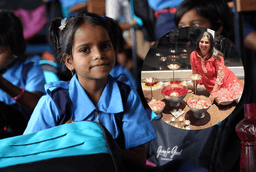

- 29 May 2024

India has always been a land of rich heritage and cultural diversity. Today, our education system focuses on skill development and experiential learning. But did you know that these ideas were sown thousands of years ago? The evolution of the Indian education system has been a fascinating reflection of a rich history that often goes unnoticed in a world of constant change. From learning Vedas under the shade of a tree to pursuing degrees online, India has witnessed a major social and cultural shift.
So, what’s the story behind Indian education, and how did it shape the system you experience today?
Imagine going to school in a forest, living with your guru or teacher, and learning through practical experiences. That was the essence of the ancient gurukul system. Students, known as brahmachārīs, learned a way of life from the age of 8 or 12 until they were 25.
Education wasn't confined to textbooks. It covered everything from the sacred Vedas to archery, astronomy, and medicine. Learning was interactive, with skill development, discussions, debates, and storytelling playing a key role. The lively debates under a banyan tree and the joy of learning with fellow students feel worlds apart from the lonely confinement of textbooks, wouldn't you agree?
Then came Nalanda University, a catalyst for ancient Indian education. Founded in the 5th century, Nalanda was the world’s first residential university, attracting 10,000 students and scholars from across the world. It was a hub of knowledge and innovation, with an extensive library housing millions of books and offering subjects ranging from astronomy to logic.
The arrival of the British Raj in the 18th century marked a turning point in the Indian education system. In 1835, Thomas Macaulay, a British politician, established the need for English education for Indian natives with the infamous "Minute on Indian Education.” Western education was introduced primarily to create a class of English-speaking workers. Schools and colleges began focusing on English, science, and math. While the colonial education system laid the foundation for modern educational institutions, it also distanced India from its rich cultural heritage.
In 1947, India was finally independent and building a strong education system. Illiteracy was a major problem in post-independent India. Hence, the central and state governments shared the responsibility, with the key goals being universal elementary education, eradicating illiteracy, and modernizing education. A big milestone was the Right to Education (RTE) Act of 2009, which implemented free education for children aged 6 to 14 and aimed to bridge socio-economic gaps by promoting inclusive education for all.
Today, the Indian education system is a mix of traditional values and modern practices. The National Education Policy (NEP) 2020 aims to change the education system with a multidisciplinary approach, experiential learning, and increased use of technology. Online learning platforms, interactive whiteboards, and educational apps are making learning more engaging and accessible. However, while there’s a wide network of schools and universities, issues like inadequate infrastructure, teacher shortages, a lack of resources, and the need for curriculum updates persist. The COVID-19 pandemic exposed these challenges further, highlighting the digital divide and the need for resilient educational systems.
With India reaching for its roots, we have the potential for a bright future. The shift from rote learning to skill-based education is a major step toward preparing students for the real world. With the emphasis on vocational training and hands-on learning, India is circling back to the skill-focused qualities of the Gurukul system. The future of Indian education lies in a balance between tradition and innovation. This requires addressing major causes like socio-economic barriers, a lack of resources and infrastructure, and a lack of action. Our journey from the serene gurukuls to the tech-powered classrooms of today teaches us the importance of inclusivity and collaboration.
A collective effort of the government, educational institutions, corporate organizations, NGOs, and individuals like you ensures that every child in India receives an education that empowers them to not only succeed but to grow in the world of opportunities. After all, education is the key to a nation's potential, and India's potential is nothing short of extraordinary!
Exclusively written for Giving for Good Foundation by Bhairavi Hiremath

With words as her medium and a diary full of scribbled ideas, she is usually found looking for ways to use her writing to impact for Good. If she’s out of sight, she’s probably either reading, petting cats, jamming to retro Bollywood, or of course, writing!